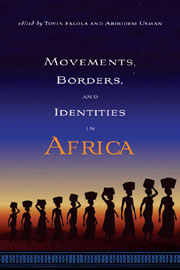Book contents
- Frontmatter
- contents
- Preface
- Introduction: Migrations in African History: An Introduction
- PART A State Formation and Migration Crossroads
- PART B Movements and Identities
- 6 Squatting and Settlement Making in Mamelodi, South Africa
- 7 “Scattering Time”: Anticolonial Resistance and Migration among the Jo-Ugenya of Kenya toward the End of the Nineteenth Century
- 8 Traders, Slaves, and Soldiers: The Hausa Diaspora in Ghana (Gold Coast and Asante) in the Nineteenth and Early Twentieth Centuries
- 9 Ethnic Identities and the Culture of Modernity in a Frontier Region: The Gokwe District of Northwestern Zimbabwe, 1963–79
- 10 Displacement, Migration, and the Curse of Borders in Francophone West Africa
- 11 Shifting Identities among Nigerian Yoruba in Dahomey and the Republic of Benin (1940s–2004)
- 12 Identity, “Foreign-ness,” and the Dilemma of Immigrants at the Coast of Kenya: Interrogating the Myth of “Black Arabs” among Kenyan Africans
- 13 Labor Market Constraints and Competition in Colonial Africa: Migrant Workers, Population, and Agricultural Production in Upper Volta, 1920–32
- List of Contributors
- Index
7 - “Scattering Time”: Anticolonial Resistance and Migration among the Jo-Ugenya of Kenya toward the End of the Nineteenth Century
from PART B - Movements and Identities
Published online by Cambridge University Press: 12 September 2012
- Frontmatter
- contents
- Preface
- Introduction: Migrations in African History: An Introduction
- PART A State Formation and Migration Crossroads
- PART B Movements and Identities
- 6 Squatting and Settlement Making in Mamelodi, South Africa
- 7 “Scattering Time”: Anticolonial Resistance and Migration among the Jo-Ugenya of Kenya toward the End of the Nineteenth Century
- 8 Traders, Slaves, and Soldiers: The Hausa Diaspora in Ghana (Gold Coast and Asante) in the Nineteenth and Early Twentieth Centuries
- 9 Ethnic Identities and the Culture of Modernity in a Frontier Region: The Gokwe District of Northwestern Zimbabwe, 1963–79
- 10 Displacement, Migration, and the Curse of Borders in Francophone West Africa
- 11 Shifting Identities among Nigerian Yoruba in Dahomey and the Republic of Benin (1940s–2004)
- 12 Identity, “Foreign-ness,” and the Dilemma of Immigrants at the Coast of Kenya: Interrogating the Myth of “Black Arabs” among Kenyan Africans
- 13 Labor Market Constraints and Competition in Colonial Africa: Migrant Workers, Population, and Agricultural Production in Upper Volta, 1920–32
- List of Contributors
- Index
Summary
There are countless numbers of works on the subject of African resistance to the coming of colonialism, yet only a select few deal with the extent to which resistance changed African demography. Only a few studies focus on the aftermath of African resistance, on the new migration and settlement patterns that emerged during and after colonial resistance. Most works on African resistance to the colonial invasion tend to focus on the preparations for resistance, the nature of resistance movements, and the immediate outcome; they rarely focus on the long-term fortunes of those who were scattered and displaced during resistance. Studies of resistance are often characterized by assumptions, for example, the assumption that after the failure of an attempt at resistance, the defeated people fled. This assumption is made without any detailed examination of how people fled, where they fled to, and why. A cursory examination of the existing materials on African movements and migrations during colonial conquests reveals many such assumptions, characterized by vague and imprecise terms and phrases such as the following: “and they were scattered to the four winds”; “and after the defeat, the leader and his community then fled”; “and the battle was over, and the resisters dispersed”; “and they were defeated, and after that they fled.” Little context is provided, and little is said about why a resisting leader and his followers chose a particular area for sanctuary.
- Type
- Chapter
- Information
- Movements, Borders, and Identities in Africa , pp. 166 - 184Publisher: Boydell & BrewerPrint publication year: 2009



